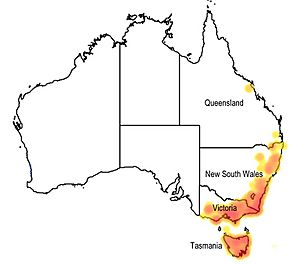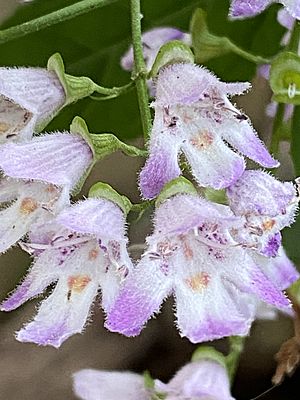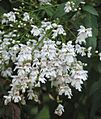Victorian Christmas bush facts for kids
Quick facts for kids Victorian Christmas bush |
|
|---|---|
 |
|
| Flowers of Prostanthera lasianthos | |
| Scientific classification | |
| Genus: |
Prostanthera
|
| Species: |
lasianthos
|
 |
|
The Victorian Christmas bush (scientific name: Prostanthera lasianthos) is a lovely shrub or small tree. It is part of the mint family, called Lamiaceae. This plant grows naturally in Australia, in places like Queensland, New South Wales, Victoria, and Tasmania. It can grow up to 10 meters (35 feet) tall, but it's usually smaller. You often find it in wet forests, especially near creeks.
Its flowers are a real highlight! They appear in big groups and are about 2 centimeters long. They are usually white or a light purple color, with cool purple and orange spots inside. These flowers bloom in late spring and summer, often right around Christmas time in Victoria, which is how it got its common name. The leaves smell nice, have small teeth, and are usually 4 to 12 centimeters long.
Contents
All About the Victorian Christmas Bush
The Victorian Christmas bush, Prostanthera lasianthos, is the biggest plant in the Prostanthera group, which are all called mint bushes. This plant can look quite different depending on where it grows. In protected forests, it might be a 10-meter-tall tree. But in windy mountain areas, it could be a smaller shrub, only about 2 meters tall.
Its dark green leaves grow in pairs along the stems. They are shaped like a spear or an egg, about 4 to 12 centimeters long. The underside of the leaf is a lighter color. The flowers can appear from November to March. They grow in clusters at the end of the branches. Sometimes, you'll see shrubs with purple flowers, especially in higher, cooler places.
After the flowers are gone, only the dried brown parts at the base remain. If the plant gets dry, its leaves might curl up like tubes. But they quickly open up again and look fresh after it rains. The flowers smell a bit like honey. Each flower has a small cup-like part called a calyx at its base. The main part of the flower, called the corolla, is white to light purple and has those cool purple spots inside.
How This Plant Got Its Name
A French scientist named Jacques Labillardière first described the Victorian Christmas bush in 1806. He found a sample of the plant in Tasmania. The scientific name lasianthos comes from two Greek words: lasios, meaning "hairy," and anthos, meaning "flower." So, it means "hairy flower."
This plant is the main example for the whole Prostanthera group. It is closely related to another plant called P. tallowa. The mint bush group belongs to the family Lamiaceae. This family also includes many other well-known herbs you might use in cooking, like true mint!
People in Australia also know this plant by other names. Some aboriginal names include coranderrk (from the Woi wurrung people) and geringdah (from the Daung wurrung people).
Over the years, scientists have found different types of P. lasianthos. These types have slight differences, like leaf texture or flower color, depending on where they grow. For example, one type found in the Grampians in Victoria has tougher, leathery leaves.
Where Does It Grow?
The Victorian Christmas bush, P. lasianthos, is found all the way from Queensland down to Tasmania. It can live in many different places. You might see it growing along river banks in wet forests. It also grows in drier, colder areas high up in the mountains.
In places like the Central Coast and Central Tablelands in New South Wales, it grows in rainforests alongside trees like yellow sassafras and coachwood. It also lives in wet forests with cedar wattle and brown barrel trees. You can even find it in drier forests with plants like forest red gum and river oak.
Who Visits the Flowers?
The flowers of the Victorian Christmas bush are shaped in a way that seems to attract insects. They have a white to purple color, a wide opening, and a large lower petal. However, we don't know a lot about which specific insects pollinate mint bushes in general. We do know that birds have been seen visiting the flowers, so they might help with pollination too!
Growing Your Own Christmas Bush
The Victorian Christmas bush grows quickly and can adapt to many different garden conditions. It can grow well in light or heavy soils. It also doesn't mind if it's in a sunny spot or a shady one, even very deep shade! This plant can handle some frost and even a bit of snow.
You can prune this plant to give it different shapes. If an old plant starts to look a bit tired, pruning can make it healthy again. If you don't prune it, it might become too heavy at the top. In the Canberra area, it flowers in November, which is earlier than in Victoria. Sometimes, new plants can sprout from the roots of an existing plant.
You can grow new plants from seeds or by taking cuttings from young, firm branches. If you store the seeds for more than three months at room temperature, they often won't grow.
Some special types of this plant, called cultivars, have been developed for gardens. 'Kallista Pink' is a tall type from the Dandenong Ranges in Victoria that has lots of pink flowers. 'Mint Ice' is another type from the Dandenongs that has cool, varied leaf colors. There's also a tall type called 'Liffey Falls' that has purple flowers.
Images for kids
-
P. lasianthos sp. 'Point Lookout', New England National Park
See also
 In Spanish: Prostanthera lasianthos para niños
In Spanish: Prostanthera lasianthos para niños





